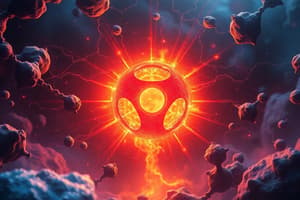Podcast
Questions and Answers
What happens to the atomic number of an atom when it emits a beta particle?
What happens to the atomic number of an atom when it emits a beta particle?
- It doubles
- It increases by one (correct)
- It decreases by one
- It remains the same
In nuclear fission, what is primarily released from the nucleus?
In nuclear fission, what is primarily released from the nucleus?
- Positrons and electrons
- Neutrons and energy (correct)
- Electromagnetic energy
- Alpha particles
What characterizes positron emission in terms of proton and neutron ratios?
What characterizes positron emission in terms of proton and neutron ratios?
- It does not depend on neutron or proton ratios
- It requires equal numbers of neutrons and protons
- It occurs with a high neutron-to-proton ratio
- It occurs with a low neutron-to-proton ratio (correct)
Which process describes the fusion of two or more elements to form a larger element?
Which process describes the fusion of two or more elements to form a larger element?
What is primarily involved during gamma ray emission from an atom’s nucleus?
What is primarily involved during gamma ray emission from an atom’s nucleus?
Which decay process involves capturing an inner electron by the nucleus?
Which decay process involves capturing an inner electron by the nucleus?
In the equation $238,92U \to 234,90Th + 4,2He + 2,0n$, which process is being depicted?
In the equation $238,92U \to 234,90Th + 4,2He + 2,0n$, which process is being depicted?
Which statement is true regarding the mass number (A) in nuclear reactions?
Which statement is true regarding the mass number (A) in nuclear reactions?
What type of radiation involves the emission of an alpha particle from an atom’s nucleus?
What type of radiation involves the emission of an alpha particle from an atom’s nucleus?
Which of the following statements regarding isotopes is true?
Which of the following statements regarding isotopes is true?
What is the term for a nuclide that results from the decay of an unstable parent nuclide?
What is the term for a nuclide that results from the decay of an unstable parent nuclide?
Which particle is released during alpha decay and contains two protons and two neutrons?
Which particle is released during alpha decay and contains two protons and two neutrons?
In nuclear fission, what is typically released as a result of the reaction?
In nuclear fission, what is typically released as a result of the reaction?
What is the half-life of a radioactive substance?
What is the half-life of a radioactive substance?
Which subatomic particle has no charge and is found in the nucleus of an atom?
Which subatomic particle has no charge and is found in the nucleus of an atom?
What is a magic number in nuclear physics?
What is a magic number in nuclear physics?
What is the significance of 'magic numbers' in nuclear stability?
What is the significance of 'magic numbers' in nuclear stability?
Which type of radiation has the highest ionizing power?
Which type of radiation has the highest ionizing power?
What is the result of a short-term exposure to high levels of radiation?
What is the result of a short-term exposure to high levels of radiation?
What is the half-life of a substance?
What is the half-life of a substance?
If 100.0 grams of Zn-71 has a half-life of 2.4 minutes, how much remains after 7.2 minutes?
If 100.0 grams of Zn-71 has a half-life of 2.4 minutes, how much remains after 7.2 minutes?
Which of the following statements accurately defines penetrating power?
Which of the following statements accurately defines penetrating power?
What is a radiotracer?
What is a radiotracer?
What can prolonged low-dose radiation exposure lead to?
What can prolonged low-dose radiation exposure lead to?
Flashcards are hidden until you start studying
Study Notes
Nucleons, Atomic Nuclei, and Atomic Number
- Nucleons are the subatomic particles found in the nucleus of an atom. These include protons and neutrons.
- Atomic nuclei are composed of protons (positively charged) and neutrons (no charge).
- Mass number (A) represents the total number of protons and neutrons in an atom.
- Atomic number (Z) represents the number of protons in an atom.
Types of Radioactive Decay
- Alpha particle (α) emission involves the release of an alpha particle (consisting of two protons and two neutrons) from the nucleus. This reduces the atomic mass by 4 units.
- Beta particle (β) emission involves the release of a beta particle (an electron) from the nucleus. This does not affect the mass of the atom but increases the atomic number by one.
- Gamma ray (γ) emission involves the release of electromagnetic energy from the nucleus. This does not involve particle emission and does not cause transmutation (change of element).
- Positron (β+) emission involves the emission of a positron (an anti-electron) from the nucleus, which occurs when the neutron-to-proton ratio is low.
- Electron capture occurs when an inner electron is captured by the nucleus, resulting in a proton transforming into a neutron.
Nuclear Reactions
- Nuclear fission is a process where the nucleus of an atom is split into smaller parts, releasing a large amount of energy.
- Nuclear fusion is a process where two or more nuclei fuse together to form a larger nucleus, also releasing a large amount of energy.
- Nuclear transmutation is the change of one element into another, often caused by nuclear reactions.
Key Definitions
- Nuclide: An atom's nucleus with a specific number of protons and neutrons (specific isotope).
- Parent nuclide: An unstable nuclide that undergoes radioactive decay.
- Daughter nuclide: The resulting nuclide after radioactive decay.
- Radioactivity: The spontaneous decomposition of atomic nuclei, releasing high-energy particles or rays.
- Isotopes: Nuclides of the same element with different numbers of neutrons.
- Radioisotope: An isotope whose nucleus undergoes spontaneous decomposition.
Half-Life
- Half-life: The time it takes for half of a radioactive sample to decay.
- Decay constant: A constant value associated with the rate of radioactive decay for a specific isotope.
Effects of Radiation
- Ionizing power: The ability of radiation to ionize molecules and atoms. More massive particles have higher ionizing power.
- Penetrating power: The ability of radiation to penetrate matter. Smaller particles have higher penetrating power.
Types of Radiation Damage
- Acute radiation damage: Occurs due to exposure to high levels of radiation over a short period, damaging cells.
- Increased cancer risk: Low radiation levels over extended periods can increase cancer risk by damaging somatic cells.
- Genetic defects: Radiation damage to DNA in reproductive cells can cause genetic defects in offspring.
Nuclear Medicine Applications
- Radiotracers: Radioactive nuclides used for medical diagnosis by tracing their pathways in the body.
Studying That Suits You
Use AI to generate personalized quizzes and flashcards to suit your learning preferences.



